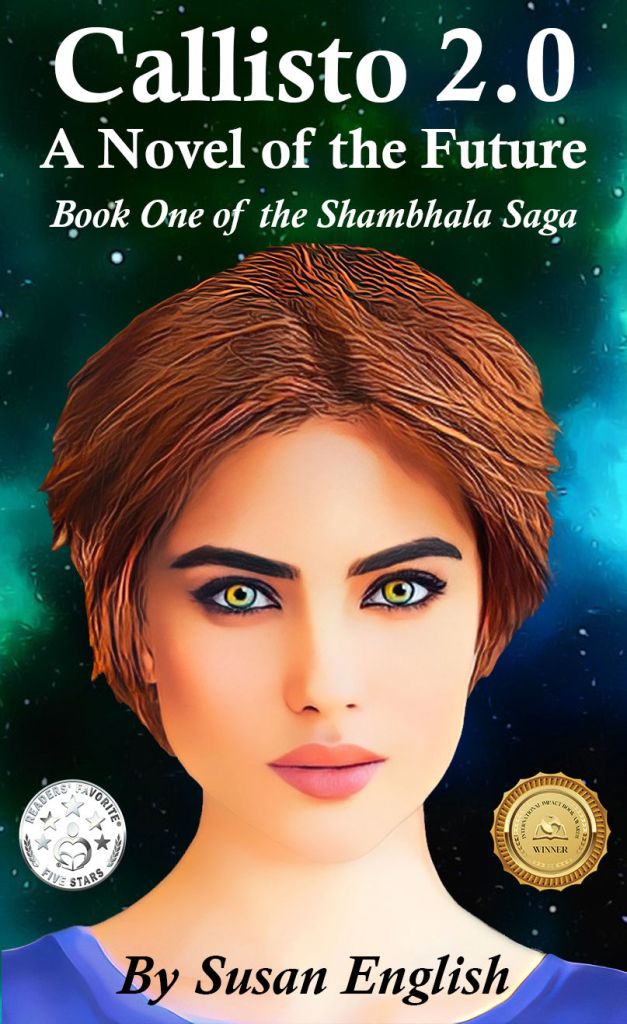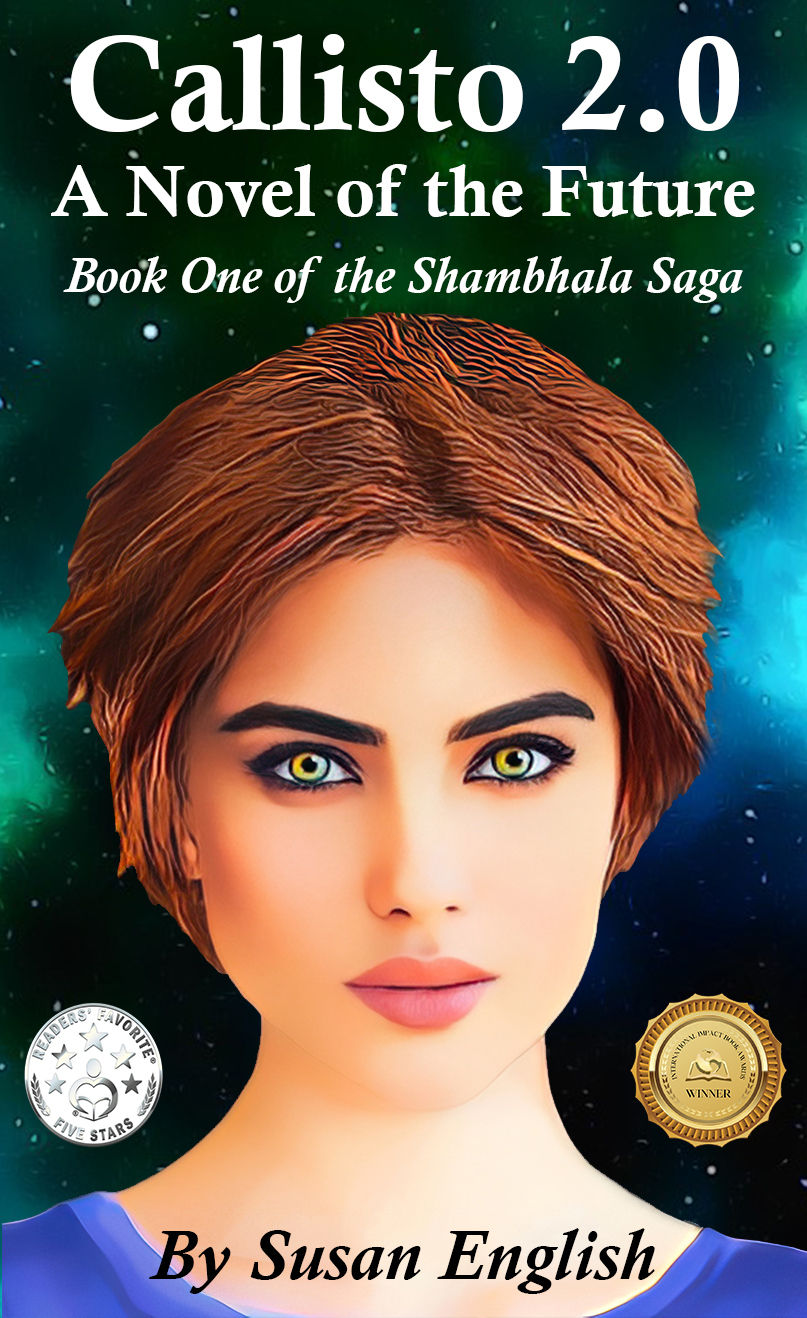
Written by Susan English
Science fiction may be known for its bombastic stories and larger than life set pieces, but the genre is broad enough to feature stories that do away with that, instead focusing on the characters that populate the world. Callisto 2.0, the first part of Susan English’s Shambhala Saga is one such book. In this instance, the characters are an all female crew of scientists, and the world is the Shambhala Space Station, circa 2097. Named for its lead character, Callisto—or Calli, as anyone other than the station’s AI, Annie, calls her—it’s a story that celebrates feminist ideals, LGBTQI+ characters, and spirituality. While the science fiction elements make for an entertaining backdrop (with the later books in the series looking like they expand on this further), for the majority of the book, they take a backseat to the novel’s character piece.
The focus on Callisto 2.0’s characters also means the book’s plot also takes a backseat to them, particularly, the titular protagonist. It tells the story of Calli being recruited to work on the Shambhala Space Station to work on warp technology, which will allow humanity to explore further into space. Upon learning the station’s crew is all female, Calli soon finds the workplace to be idyllic. The staff all work together through a common purpose, without undercutting one another. The book chronicles Calli’s journey on the space station, with little overarching plot. Towards the end of the novel, issues come to the fore, adding some excitement to the story; something it lacks through the remainder of it—even errors with huge ramifications to the program have little ramifications for the characters.
At an estimated 404 pages on Kindle (the only way to purchase the book), Callisto 2.0 is a reasonably long read, particularly given its focus on characters above plot. While this approach may irk readers who expect intricate plots in their books, the characters’ arcs—particularly Calli’s—shine. A deep plot isn’t necessary to enjoy the book, and the light touch works perfectly well. It works so well, in fact, that a detailed plot that imperils the space station and those on board would have distracted from the characters and diluted its overarching themes. With the lack of a narrative throughline, it moves at a gradual pace, which it uses to explore the lives on the station, much of it on the mundane day-to-day. This approach works in the book’s favour, and while it means that not much of consequence happens throughout its majority, the day-to-day life of these scientists is always fun to follow.
As important as Calli and her cohorts are to Callisto 2.0, the book’s themes are equally so. As noted above, life working on a space station that only houses women represents a peaceful life for her. The Shambhala Space Station is a matriarchy, and through this, English discusses the differences between this and the patriarchy on Earth. The novel is a work of feminist literature that promotes positivity and inclusivity, not only in relation to feminism, but in regard to LGBTQI+ people and religion. Calli is a lesbian, out and (presumed) proud, something the book explores through its pages. While a focus of the book, instead of it simply being who Calli is, it still enshrines gay relationships as normal. As based in science as the book is, freedom of religion plays a large part throughout, regardless of whether people are Christian, Buddhist, or worship the ancient Greek pantheon—like Calli’s parents, who named her after the princess of Greek myth.
While the book’s themes are important, the discussions between characters about them don’t ring true. These feel stilted and sometimes feel like the words are there to provide exposition about them, rather than having the story illustrate them. The result is conversations touching upon these themes don’t feel entirely natural. Outside of the themes, the dialogue works for the most part, but there are awkward exchanges interspersed throughout the text. These characters all sound distinct from one another, and their own voices assist both the story and its setting.
Although the dialogue is uneven, English’s prose shines throughout Callisto 2.0. Written in the first person, it covers the story from its protagonist’s point of view. The language used is clear and avoids unnecessary complications. Most importantly, especially given it’s written in the first person, this text has a fantastic voice. It’s voiced by an engaging character, and this translates to the writing. It describes settings and events, while also providing a glimpse at Calli’s inner thoughts, and conveys much of the book’s optimism.
No matter how well written first person prose is, if the lead character isn’t well developed, it can only go so far. Calli is a wonderfully developed character, and given the focus on her, it enhances the narrative. She is a fully human character, with wins and losses, both by her own making. Despite working on warp technology in a space station towards the end of the twenty-first century—a situation very few readers will relate to—she is entirely relatable. The Shambhala Space Station is populated by a wide variety of characters whose roles in the story vary wildly, and each one is entertaining to follow. While they can’t be presented with the same amount of depth as Calli, they are all entertaining to follow, instead of being used to simply further the plot.
As I’ve previously mentioned, Callisto 2.0 is the first part of a series, and it’s only towards the end of the book that tensions rise. When this occurs, it’s building towards a cliffhanger to be resolved in the rest of the series. It’s a fantastic cliffhanger, and the build towards it is expertly handled. However, if you’re after a book that stands on its own, this isn’t it. It’s very much the opening chapter in a series, with so much story to tell.
Callisto 2.0 is an untraditional science fiction tale that places its characters and themes above the plot and setting. This serves the novel incredibly well, but readers expecting a hard science fiction story may be disappointed. Although some of the dialogue doesn’t work as well as it could, it remains a thoroughly entertaining story that brings togetherness, LGBTQI+ relationships and feminism to the fore.
Favourite Passage
Diana was not the one for me. But her charm, her beauty, her kindness, and her attention—it was enough to knock anybody off their feet. Now that I could think more clearly, I didn’t know when or even if I would ever find someone to share my life with, and maybe being single was fine, too. But it was time to move on to the next stage of my life, whatever that might entail. I wanted to be ready and open to the possibilities.
Callisto 2.0: Book One of the Shambhala Saga, Chapter Five
Callisto 2.0: Book One of the Shambhala Saga was purchased for the purpose of an honest review.
Callisto 2.0 is available on Kindle, exclusive to Amazon.
Note: I do not post scores for reviews on this website, but do post them on my Amazon and Goodreads reviews:
- Amazon
- Goodreads
You can follow Susan English online, via:

Interested in purchasing Callisto 2.0: Book One of the Shambhala Saga?
Please find a link below; please note I do not collect any proceeds from the sale.
Callisto 2.0: A Novel of the Future (Book 1 of the Shambhala Saga LGBTQ+ Science Fiction Series)

